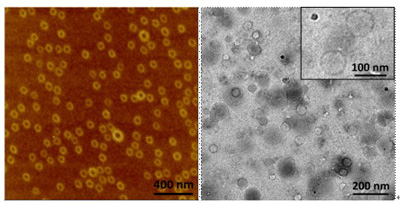

The Influencing Factors on the Ring-shaped Morphology in PI-b-P2VP Diblock Copolymer
Received date: 2013-03-06
Online published: 2013-05-02
Supported by
Project supported by the National Natural Science Foundation of China (Nos. 21074026, 20990231) and National Basic Research Program of China (No. 2011CB605700).
Recently, Chang et. al. reported ring-shaped micelles of highly uniform shape and size could be formed from polyisoprene-block-poly(2-vinylpyridine) (PI-b-P2VP) diblock copolymer in THF/ethanol solvent mixture (Angew. Chem. 2009, 121, 4664). Based on their work, we prepared the ring-shaped morphology films by adding P2VP selective solvent (ethanol) dropwise into a mixture of PI-b-P2VP block copolymer in their co-solvent tetrahydrofuran with a certain volume ratio of THF/ethanol and spin-coating the solution onto the silica wafers. We systematically investigated the influencing factors on the ring-shaped morphology by tapping mode atomic force microscopy (AFM), including copolymer concentrations (0.01, 0.02, 0.2, 0.4 and 2 mg/mL), the ratios of THF to ethanol (from 100:0, to 10:200), solvent selectivity (ethanol, acetone, water selective for P2VP and toluene selective for PI), solvent evaporation rates (0.048, 0.15, 0.3 mL/h), solvent dropping sequence and the dropping rates of selective solvent (1.13 mL/h, 6.72 mL/h and injecting ethanol directly into the solution). The existence of solvent selective for P2VP and the ratio of THF to ethanol were essential for the formation of rings. In order to analyze the structure of the ring morphology, chloroauric acid (HAuCl4) was selectively loaded into P2VP phase by complexation and detected by AFM. Combining these results with dynamic light scattering (DLS), static light scattering (SLS) and cryo-transmission electron microscopy (cryo-TEM), a possible formation mechanism of rings was proposed: with the addition of ethanol which is a selective solvent for P2VP, PI-b-P2VP gradually self-assembled into ring-shaped micelles with the outer corona composed of P2VP and the inner core constituted of PI block. On the basis of a series of research, it is possible to control the ring morphology by changing experimental conditions which is promising for patterning application.

Yang Hui , Peng Juan , Qiu Feng . The Influencing Factors on the Ring-shaped Morphology in PI-b-P2VP Diblock Copolymer[J]. Acta Chimica Sinica, 2013 , 71(08) : 1141 -1148 . DOI: 10.6023/A13030245
[1] Bates, F. S. Annu. Rev. Phys. Chem. 1990, 41, 525.
[2] Zhu, J.; Liao, Y.; Jiang, W. Langmuir 2004, 20, 3809.
[3] Talingting, M.; Munk, P.; Webber, S.; Tuzar, Z. Macromolecules 1999, 32, 1593.
[4] Riegel, I.; Eisenberg, A. Langmuir 2002, 18, 3358.
[5] Raez, J.; Manners, I.; Winnik, M. J. Am. Chem. Soc. 2002, 124, 10381.
[6] Li, Z.; Chen, Z.; Cui, H.; Hales, K.; Qi, K.; Wooley, K.; Pochan, D. Langmuir 2005, 21, 7533
[7] Cornelissen, J.; Fischer, M.; Sommerdijk, N.; Nolte, R. Science 1998, 280, 1427.
[8] Voets, I.; De Keizer, A.; De Waard, P.; Frederik, P.; Bomans, P.; Schmalz, H.; Walther, A.; King, S.; Leermakers, F.; Cohen Stuart. M. Angew. Chem. 2006, 118, 6825.
[9] Zhang, L.; Eisenberg, A. Polym. Adv. Technol. 1998, 9, 677.
[10] Zhu, J.; Jiang, W. Macromolecules 2005, 38, 9315.
[11] Zhang, L.; Eisenberg, A. Science 1995, 268, 1728.
[12] Walther, A.; Goldmann, A.; Yelamanchili, R.; Drechsler, M.; Schmalz, H.; Eisenberg, A.; M黮ler, A. Macromolecules 2008, 41, 3254.
[13] Bai, Z.; He, Y.; Lodge, T. Langmuir 2008, 24, 5284.
[14] Kim, B.; Park, S.; McCarthy. T.; Russell, T. Small 2007, 3, 1869.
[15] Zhu. J.; Jiang, W. Macromolecules 2009, 42,399.
[16] Gong, Y.; Hu, Z.; Chen, Y.; Huang, H.; He, T. Langmuir 2005, 21, 11870.
[17] Lee, E.; Jeong, Y. H.; Kim, J. K.; Lee, M. Macromolecules 2007, 40, 8355.
[18] Li, X.; Deng, M.; Liu, Y.; Liang. H. J. Phys. Chem. B 2008, 112, 14762.
[19] He, X.; Schimid. F. Phys. Rev. Lett. 2008, 100,137802.
[20] Huang, H.; Chung, B.; Jung, J.; Park, H.; Chang, T. Angew. Chem. 2009, 121, 4664.
[21] Wei, Y. H.; Li, B. Y. Han, Y. C.; Pan, C. Y. Soft Matter 2008, 4, 2507.
[22] Brandrup, J.; Immergut, E.H.; Grulke, E. A.; Abe, A.; Bloch, D. R. Polymer Handbook (4th ed ), New York, 1999.
/
| 〈 |
|
〉 |